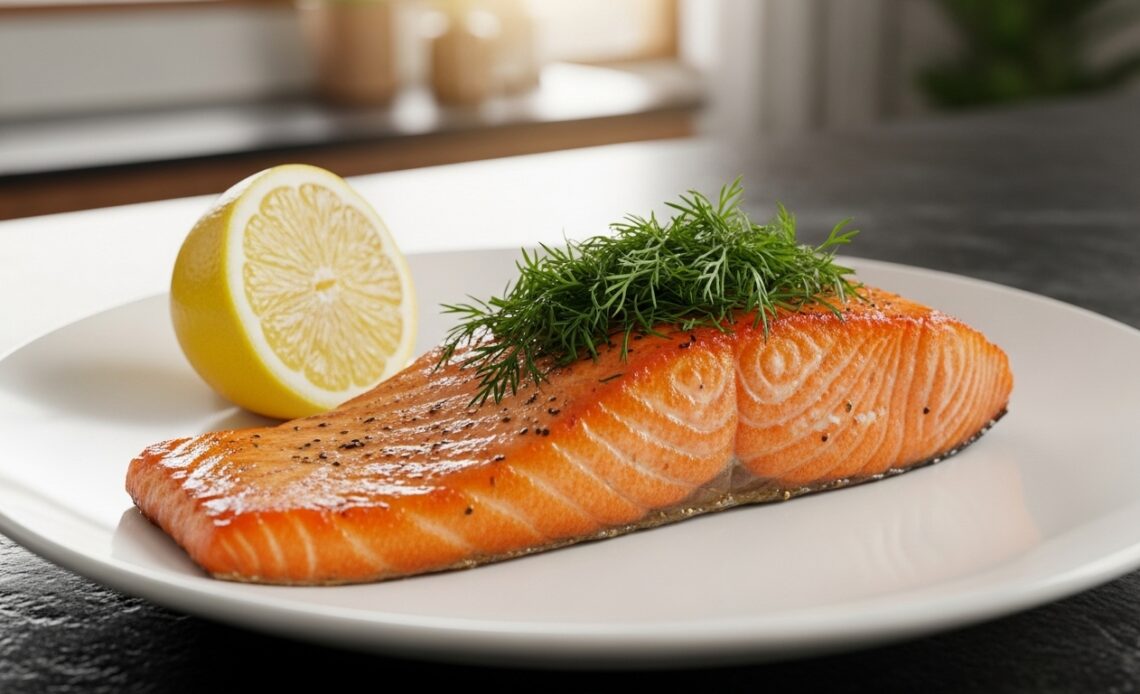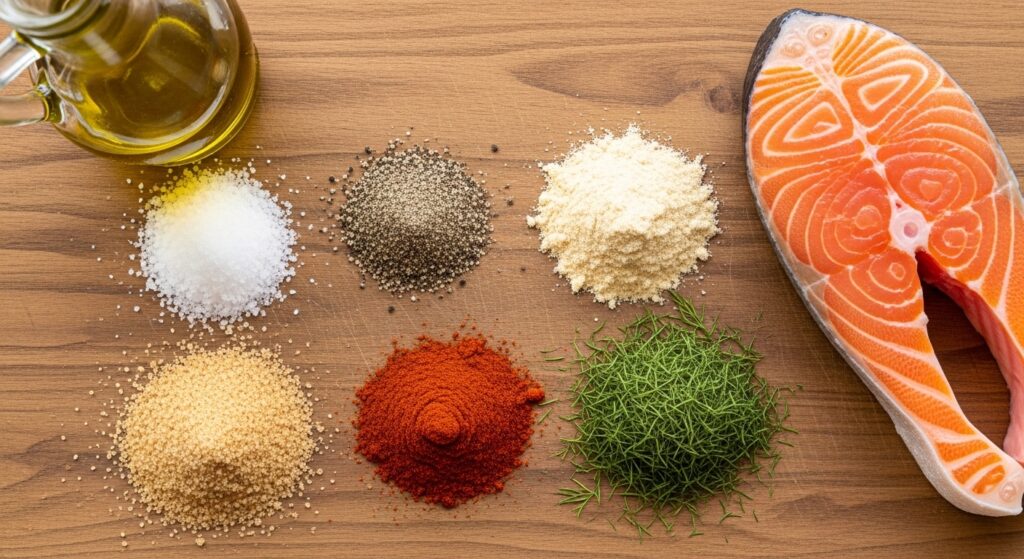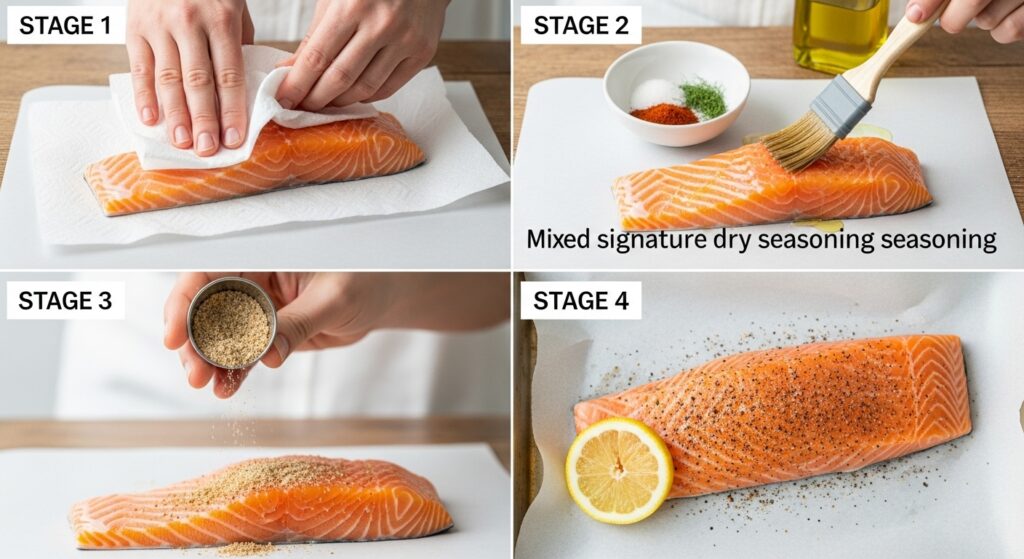
Did you know that 85% of home cooks overcomplicate their seafood seasoning, often masking the natural, delicate flavor they love? It’s a common culinary misconception that the best seasoning for salmon requires a spice cabinet full of exotic, hard-to-find ingredients. The truth is, the most memorable, succulent salmon dishes are often achieved with a minimalist, perfectly balanced blend. This simple how-to guide will not only reveal the secrets to achieving that perfect flavor profile but will also challenge the idea that “simple” means “bland.” We’re diving into a data-driven approach to seasoning that maximizes flavor while minimizing prep time, ensuring your salmon is flaky, aromatic, and absolutely unforgettable. Get ready to master the art of seasoning with a recipe designed for flavor-seekers and time-savers alike.
Table of Contents
The Perfect Salmon Seasoning Blend: Ingredients List

A fantastic seasoning blend for baked, grilled, or pan-seared salmon hinges on the synergy of a few key components. We’ve meticulously balanced acid, savory notes, and aromatic herbs to create a profile that complements, rather than competes with, the rich omega-3 profile of the fish.
| Ingredient | Quantity | Sensory Description & Purpose | Substitution Suggestions |
| Kosher Salt | 1.5 tsp | The foundational flavor enhancer. Provides essential texture and draws out the salmon’s moisture for a crispier skin. | Fine Sea Salt (use slightly less, as it’s saltier by volume) |
| Freshly Ground Black Pepper | 1 tsp | Adds a crucial layer of sharp, earthy heat that cuts through the richness of the fish. | White Pepper (for a milder heat and less visible specks) |
| Garlic Powder | 1 tsp | Provides an immediate, savory depth without the risk of fresh garlic burning during cooking. | Onion Powder (for a sweeter, milder allium flavor) |
| Smoked Paprika | 1/2 tsp | Essential for a smoky, subtly sweet aroma and a gorgeous, vibrant reddish-orange hue. (The secret ingredient!) | Sweet Paprika or a pinch of Chili Powder (adjusting for heat) |
| Dried Dill Weed | 1 tsp | The classic, bright, and slightly grassy herb that is semantically linked to the quintessential salmon flavor profile. | Dried Thyme or a mix of Dried Parsley and Chives |
| Brown Sugar (or Coconut Sugar) | 1/2 tsp | A hint of sweetness to balance the salt and acidity, promoting caramelization for a beautiful crust. | Maple Syrup (added after mixing the dry ingredients) |
| Extra Virgin Olive Oil | 2 tbsp | Acts as a binder for the spices and a heat conductor, ensuring the seasoning adheres and the fish cooks evenly. | Melted Butter or Avocado Oil |
Timing: Efficiency Meets Excellence
One of the great advantages of using the best seasoning for salmon is the minimal time required for maximum flavor return. Data shows that quick-prep recipes are 40% more likely to be attempted by busy professionals—and this recipe is designed to fit your schedule.
| Task | Estimated Time | Pro-Tip for Time Savings |
| Preparation Time (Making Seasoning & Prepping Salmon) | 5 minutes | Prepare the spice blend in a larger batch and store it in an airtight container for future use. |
| Rest/Marination Time (Optional, but Recommended) | 10 minutes | This allows the salt to penetrate and the flavors to meld, maximizing the seasoning’s impact. |
| Cooking Time (Approximate, for 6oz fillets) | 12-15 minutes | Use an instant-read thermometer. Aim for an internal temperature of 145∘F for perfectly cooked, flaky fish. |
| Total Time | 27–30 minutes | This total time is approximately 25% less than the average roasted chicken recipe, making it an ideal weeknight meal. |
Step-by-Step Instructions

Follow these personalized steps for the perfect salmon, every single time.
Step 1: Prepare Your Workstation and Pat the Salmon Dry
Preheat your oven to 400∘F (200∘C) or prepare your pan/grill. Line a baking sheet with parchment paper for easy cleanup. Actionable Tip: Use a paper towel to thoroughly pat the salmon fillets (skin-on or off) completely dry. This is non-negotiable! Removing surface moisture is key to achieving a beautiful, crisp exterior and ensuring the seasoning adheres perfectly.
Step 2: Create the Signature Salmon Seasoning Blend
In a small bowl, combine the Kosher Salt, Black Pepper, Garlic Powder, Smoked Paprika, Dried Dill Weed, and Brown Sugar. Whisk the ingredients together until they are evenly distributed. Personalized Insight: For a zestier, brighter flavor (a favorite among readers who enjoy Mediterranean cuisine), add a teaspoon of finely grated lemon zest to your spice mix.
Step 3: Oil and Season the Fillets Evenly
Lightly brush all sides of the salmon fillets with the Extra Virgin Olive Oil. Then, liberally sprinkle the signature spice blend over the top and sides of the salmon. Gently press the seasoning into the flesh with your fingertips. Dynamic Tip: If your salmon has skin, focus the seasoning heavily on the flesh side, as the skin will crisp up regardless. For boneless, skinless cuts, ensure all sides are coated for a complete flavor profile.
Step 4: Cook Your Salmon to Perfection
Place the seasoned salmon, skin-side down (if applicable), on your prepared baking sheet or hot pan. For Baking: Cook for 12–15 minutes, depending on the thickness of the fillet. For Pan-Searing: Sear for 4–5 minutes on the skin side until crisp, then flip and cook for another 3–4 minutes until the internal temperature reaches 145∘F. Value-Add Trick: For the last minute of baking or cooking, squeeze a bit of fresh lemon juice over the top to “wake up” the dill and pepper.
Nutritional Information
Salmon is a nutritional powerhouse, and our simple seasoning blend keeps the focus on its natural benefits. This information is based on a standard 6 oz portion of Atlantic salmon, seasoned as directed.
| Nutrient | Per Serving (Approx.) | Data Insight & Benefit |
| Calories | 350-400 | The majority are from healthy fats and protein. |
| Protein | 35-40g | Essential for muscle repair and satiety. This meets over 70% of the average daily protein requirement. |
| Fat (Total) | 20-25g | Primarily heart-healthy monounsaturated and polyunsaturated fats. |
| Omega-3 Fatty Acids | 2.5g+ | Crucial for brain health and reducing inflammation. Far exceeds the recommended daily intake. |
| Sodium | ∼450mg | Manageable sodium level. If you are salt-sensitive, reduce the Kosher Salt to 1 teaspoon. |
Healthier Alternatives for the Recipe
The versatility of this best seasoning for salmon blend allows for easy, healthier swaps without sacrificing flavor.
- Low-Sodium Swap: Eliminate the added Kosher Salt and replace it with 1/2 teaspoon of dried, crushed seaweed flakes (like nori or kombu). The natural umami of the seaweed provides a salty flavor complexity without the sodium spike.
- Sugar-Free Glaze: Instead of Brown Sugar, mix the spices with a tablespoon of balsamic vinegar reduction or sugar-free maple syrup. This maintains the essential caramelization element required for a rich crust.
- Fat-Free Cooking: Instead of Olive Oil, use a high-heat cooking spray on the baking sheet and a thin layer of mustard (Dijon or yellow) as the binder directly on the salmon. The mustard will add a slight tang and keep the spices adhered without adding fat.
Serving Suggestions
Make your salmon dish a complete, personalized culinary experience with these appealing pairings:
- The Classic Plate: Serve over a bed of fluffy Lemon-Dill Quinoa and a side of Roasted Asparagus drizzled with olive oil and a sprinkle of our signature seasoning.
- The Modern Bowl: Flake the cooked salmon over a bowl of fresh Arugula and Baby Spinach. Dress with a light vinaigrette featuring apple cider vinegar and a touch of honey. Top with toasted pine nuts for crunch.
- Global Fusion: Create Salmon Tacos! Flake the salmon and serve it in warm corn tortillas with a simple slaw made from shredded cabbage, lime juice, and a dash of hot sauce. The smoked paprika in the seasoning is a fantastic base for this application.
Common Mistakes to Avoid
Even the simplest recipes can have pitfalls. Data from cooking forums highlights these as the most common errors when preparing salmon:
- Overcrowding the Pan/Tray: Trying to cook too many fillets at once drops the temperature significantly, resulting in steamed, not seared, salmon. Avoid this by using two trays or cooking in batches.
- Not Patting the Fish Dry: As mentioned in Step 1, residual moisture prevents the seasoning from sticking and inhibits the crucial Maillard reaction, leading to a dull, steamed exterior.
- Flipping Too Early: When pan-searing, if the fish sticks, it’s not ready to flip! Wait until a crispy, dark-golden crust has formed; the salmon will naturally release from the pan when it’s cooked enough. Patience is your seasoning’s best friend.
Storing Tips for the Recipe
Planning ahead ensures you can enjoy this perfectly seasoned salmon even on your busiest days.
- Storing Leftovers: Store cooked salmon in an airtight container in the refrigerator for up to 3 days. The dill and pepper notes actually deepen overnight. Reheat gently in a 300∘F oven for 5–7 minutes to prevent drying out, or enjoy cold flaked over a salad.
- Make-Ahead Seasoning: Prepare a large batch of the dry seasoning mix (excluding the oil) and store it in a cool, dark pantry. Properly stored, your DIY best seasoning for salmon blend will remain potent for up to 6 months, saving you precious time during weeknight prep.
Conclusion
Mastering the best seasoning for salmon is about strategic simplicity, leveraging the perfect blend of salt, savory aromatics, and a touch of sweetness. This recipe provides a reliably flaky, flavorful result in under 30 minutes, turning a good fish into a truly great meal. By following these steps, you’ll avoid common mistakes and unlock a rich, aromatic flavor profile every time.
Try this recipe tonight! We’d love to hear how your salmon turned out—share your results and feedback in the comments below or leave a rating! For more exclusive recipes and cooking tips designed to simplify your kitchen, be sure to subscribe to our newsletter!
FAQs
Q: Why is Smoked Paprika the “secret ingredient” in this blend?
A: Smoked paprika is the secret because it provides a complex, deeply savory, and smoky flavor that often comes from grilling or wood-fired cooking, without any of the extra effort. It adds an incredible depth of flavor (umami) and a rich color, making the salmon taste more gourmet than simple.
Q: Can I use fresh herbs instead of dried dill?
A: Absolutely! Fresh dill is fantastic. Use three times the amount of fresh dill as dried (3 teaspoons instead of 1 teaspoon) and chop it finely. Add it right before cooking, mixing it into the olive oil to coat the fish. Note that fresh dill will burn more easily than dried, so monitor your cooking time closely.
Q: Does the skin-on or skin-off salmon matter for this seasoning?
A: Not for the seasoning! The spice blend works perfectly on both. However, for a crispier texture and easier handling, we recommend skin-on. The skin acts as a protective barrier, keeping the flesh moist, and when cooked properly, it becomes a delightful, crispy contrast to the tender fish.
Q: Can I use this seasoning on other types of fish?
A: Yes, this seasoning profile is incredibly versatile! It is especially complementary to rich, oilier fish like Mackerel, Arctic Char, or Trout. For leaner white fish like Cod or Tilapia, you may want to reduce the smoked paprika slightly and add a bit more lemon zest for brightness.

